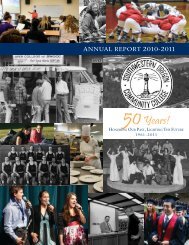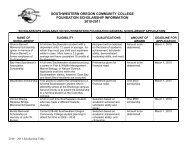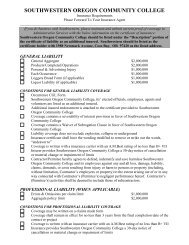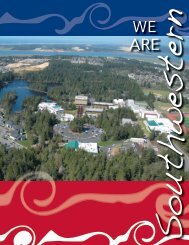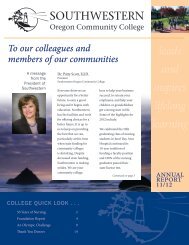Part 1 3.7.qxp - Southwestern Oregon Community College
Part 1 3.7.qxp - Southwestern Oregon Community College
Part 1 3.7.qxp - Southwestern Oregon Community College
You also want an ePaper? Increase the reach of your titles
YUMPU automatically turns print PDFs into web optimized ePapers that Google loves.
Course Descriptions<br />
FS5246 National Fire Protection Association<br />
(NFPA) Firefighter II<br />
3.5 credits (3 lec, 1 lab hr/wk)<br />
The purpose of this course is to provide the more skilled<br />
fire science student with the “intermediate” knowledge<br />
and hands-on skills necessary to be involved in fire<br />
suppression activities under the general supervision of a<br />
skilled officer. Students completing this course have met<br />
the NFPA 1001 standards for certification as NFPA<br />
Firefighter IIs.<br />
Prerequisites: FS5244 and FS5245 with a “C” or better.<br />
FS5253 Fire Apparatus and Equipment<br />
3 credits (2.5 lec, 1 lec-lab hrs wk)<br />
This course provides students with information on care<br />
and preventive maintenance of emergency vehicles, safe<br />
operating practices, and techniques necessary for safely<br />
pumping water from various types of engines. This<br />
course meets part of the training requirements for NFPA<br />
Apparatus Operator (NFPA Standard 1002). FS5257<br />
completes the training requirements for NFPA Apparatus<br />
Operator.<br />
Prerequisite: FS5240 or FS5244 with a “C” or better.<br />
FS5254 Introduction to Fire Protection<br />
3 credits (3 lec hrs/wk)<br />
This course introduces the student to different aspects of<br />
the fire protection career field. It is primarily intended for<br />
the person who wishes to become a firefighter. This class<br />
is considered the foundation course for all of the fire<br />
science technology students. Included is an overview of<br />
aspects of the hiring/selection process, fire protection<br />
opportunities other than structural firefighter positions<br />
(emergency medical technician, wildland firefighter,<br />
airport firefighter, search and rescue team members, fire<br />
prevention, etc.) and resources utilized in the fire service.<br />
Also, the students will be introduced to the concept of the<br />
systems approach to fire protection by presenting<br />
the components of modern fire department responsibility,<br />
including emergency incident management, public<br />
education, training, resource management, and<br />
customer service.<br />
FS5257 Fire Service Hydraulics<br />
3 credits (3 lec hrs/wk)<br />
The goal of this course is to present and explain the<br />
different formulas and methods for correctly calculating<br />
engine pressure during pumping operations. It is vital to<br />
safe and effective fire ground operations that the<br />
driver/operator be able to properly calculate engine<br />
pressures while operating a pumper.<br />
FS5259 Fire Organization and Command<br />
3 credits (3 lec hrs/week)<br />
The course is designed to provide students with basic<br />
concepts of organizational structure and command<br />
sequences associated with emergency scene<br />
management. Students will receive training on basic<br />
elements of the Incident Command System (ICS),<br />
preparation for company officer emergency scene<br />
management, and decision making process for managing<br />
company tactical operations (MCTO).<br />
FS5276 S-130/190 Wildland Firefighter Type II<br />
3 credits (33 lec, 7 lab hrs/total)<br />
This entry-level course is designed to train new<br />
firefighters in basic wildland fire fighting skills. Firefighters<br />
successfully completing this course will be qualified to<br />
suppress wildland fires under close supervision. This<br />
course comprises four separate wildland classes; I-100<br />
(Introduction to Incident Command System), S-130<br />
(Basic Wildland Firefighter Training), S-190<br />
(Introduction to Fire Behavior) and PMS-416 (Standards<br />
for Survival). This training is required for all personnel<br />
prior to certification as a Firefighter (Type 2) under the<br />
National Wildfire Coordinating Group (NWCG) wildland<br />
qualification system.<br />
FS5279 S-212 Wildfire Powersaws<br />
2 credits (20 lec, 8 lab hrs/total)<br />
The course is a “skill” course that is designed to<br />
instruct prospective chain saw operators in the Job<br />
Performance requirements (JPRs) of the wildfire<br />
powersaw operator position.<br />
FS5280 Cooperative Work Experience<br />
1-3 credits (3-9 hrs/wk)<br />
Maximum of 6 credits applicable toward degree. This<br />
course consists of a planned program of observation and<br />
practical experience in a selected organization within the<br />
fire suppression field, or with an organization whose work<br />
is related to firefighting. This course is designed to give<br />
fire science degree students actual field experience and<br />
the opportunity to apply fire science concepts, theory,<br />
and training in field situations.<br />
Prerequisite: Instructor consent.<br />
<strong>Southwestern</strong> <strong>Oregon</strong> <strong>Community</strong> <strong>College</strong> 2006-07 Catalog www.socc.edu Course Descriptions 170



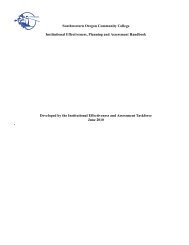
![SWOCC Viewbook [PDF] - Southwestern Oregon Community College](https://img.yumpu.com/26373688/1/190x245/swocc-viewbook-pdf-southwestern-oregon-community-college.jpg?quality=85)
